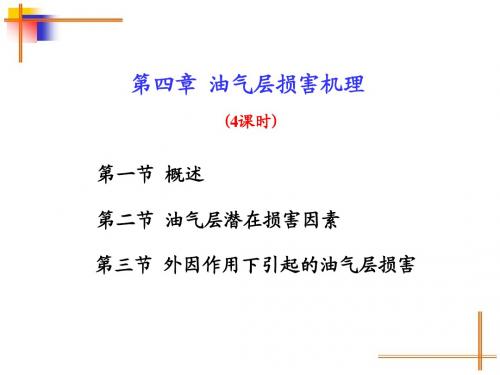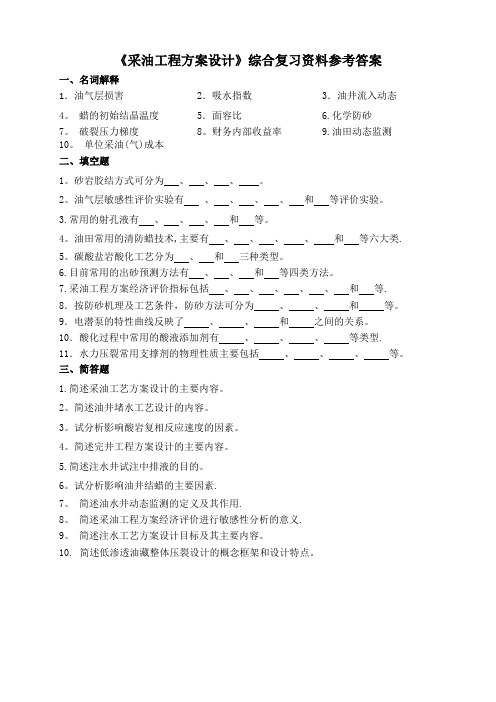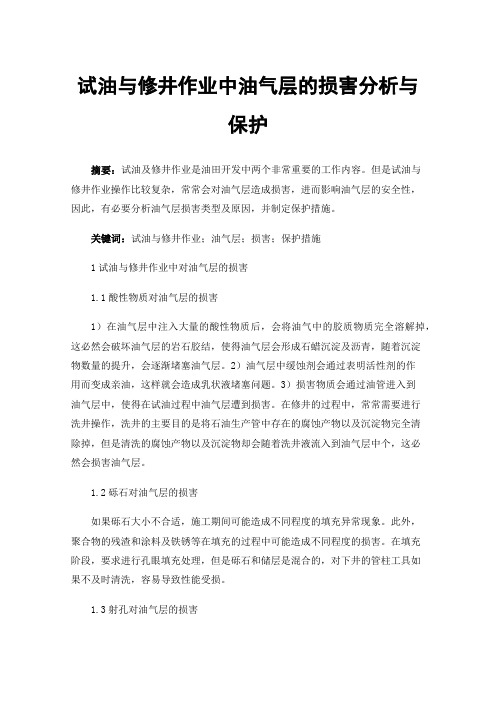5.油气层损害诊断
第八章油气层损害的矿场评价技术

3.滤液侵入直径的惯例评价方法
评价方法深、浅双侧向和微球形聚焦测井曲线组合不但能指 示储集层遭到了钻井液的侵入,而且能定量地求出侵入带直径。 深、浅双侧向和微球形聚焦测井曲线组合确定滤液侵入直径是 目前普遍采用的惯例评价方法
该方法的实施依赖于一系列的图版完成,仅能提供侵入直径 的近似值,得不到井周围地层流体性质的变化规律,从而阻碍 了测井评价储层损害深度任务的顺利实施
1.表皮效应与表皮系数
表皮效应: 想象在井筒周围有一个很小的环状区域。 由于种种缘由,使这个小环状区域的浸透率与油层 不同。当原油从油层流入井筒时,在这里会发生一 个附加压降ΔPS ,这种现象叫做表皮效应。
表皮系数〔S〕:把井筒周围很小的环状区域内发生 的附加压降无因次化,失掉无因次附加压降 ,称为 表皮系数,它表征一口井表皮效应的性质和油气层 损害的水平。
一、指示油气层遭到钻井液滤液侵入的方法
1.推移测井资料能反映钻井液滤液侵入
图8-8是 塔里木 油田轮 南 57井 钻开油 层后 2d 和 20d 两次测 量的感 应测井 曲线
华北油 田岔河 集岔3126井随 时间推 移测井 综合图 8-9
2. 深、浅双 侧向测井和 微球形聚焦 测井求侵入 带直径
d
Sd — 纯表皮系数,无因次; K、Kd—原始浸透率、污染区浸透率,um2; rd、rw—污染区半径、井眼半径,m。
S——总表皮系数
总表皮系数S为纯损害表皮系数Sd与拟表皮系数 之和
2.有效半径 在K、 rw 、Sd条件下,并不能同时求得rs及Kd 。 为了处置这个效果,引入井筒有效半径rc的概念。 设此半径能使理想〔未改动浸透率〕井的压降等 于实践井(具有表皮效应)的压降。即:
第八章油气层损害的矿 场评价技术
钻井油气层损害评价新方法

井底污染半径法
井底污染半径(rd)反映钻井液等 外来流体侵入油气层的深度,是表示 损害程度的一项重要指标。
油气层损害评价新方法
改进的X射线衍射分析法; 研究水平井储层损害的模拟试验;
泥饼机械性能的测量方法;
泥饼清除的影响因素及评价方法; 冷冻电镜扫描技术; 人工神经网络智能技术; 气层储层损害的评价方法;
多岩心动态滤失装置。
一、改进的X射线衍射分析法
评价粘土水化膨胀对渗透率的影响,以前是通过岩心流动 实验来完成的。 在岩心流动实验中,通常会出现渗透率下降或注入压力 增加,从而反映出储层受到了损害。然而该项实验需要花费大 量的时间,还要有充足的岩心作保证。另外,储层损害的机理 有很多,往往不能肯定渗透率下降是否由粘土水化膨胀所引起。 因此,岩心流动实验并不能完全反映粘土膨胀的情况。 而传统的X-衍射分析只能用于测定粘土矿物的组成,而 无法对水化程度进行评价。针对这一问题,研究出一种经改进 的X-射线衍射方法。
流动效率法
流动效率(Flow Efficiency)表示在获得相同 原油产量的条件下,油气层受到损害后的采油 指数(PI)与未受到损害时的理想采油指数(PI)0之 比值。
流动效率越驱近于1,表明油气层受到的损 害越小。
污染系数法
一般认为,污染系数等于1与产能比
的差值,即
DF=1-PR
显然,当油气层未受到损害时,DF=0;
六、人工神经网络智能技术
人工神经网络可用来模拟人的求知、
对话、预测、控制等能力。这种新的智能 化技术初步可以应用于对油藏岩石润湿性 和油/水两相相对渗透率进行预测。
人工神经网络智能技术的特点
人工神经网络通过对所输入数据进行训练,可 得到油 / 水相对渗透率曲线。预测润湿性时仅需输 入 两 个 参 数 , 即 Swc( 初 始 共 生 水 饱 和 度 ) 和 Sor (残余油饱和度)。与实验结果相比,对于岩石 / 流体系统,对润湿性的预测精度可达90 %,对边界 点的预测精度可达85%。 其优点是输入参数少,所需成本低,且准确性 较高。
第四章 油气层损害机理

薄膜式产状
(2)栉(zhi)壳式 粘土矿物叶片垂直于颗粒表面
生长,表面积大,又处于流体 通道部位,呈这种产状以绿泥 石为主,流体流动时阻力大。 因此极易受高速流体的冲击, 然后破裂形成颗粒随流体而运 移。若被酸蚀后,形成Fe(OH)3 胶凝体和SiO2凝胶体,堵塞孔 喉。
b. 土酸与岩石的反应
②造成储层酸敏性的原因
a. 铁的氢氧化物沉淀
当pH=2时,Fe3+开始生成Fe(OH)3沉淀,pH=4时, Fe3+几乎全部转变成Fe(OH)3沉淀;当pH到6~7时, Fe2+开始生成Fe(OH)2沉淀,当pH=9.7时,Fe2+几乎 全部生成Fe(OH)2沉淀。
当pH在2~7之间,石英表面电荷与Fe(OH)3胶体表面 电荷相反,促使Fe(OH)3在石英表面的吸附沉积。 b. 氢氧化铝沉淀的生成 Al 3+ + 3OHAl(OH)3
岩石的基本特征。
1)碎屑颗粒 碎屑颗粒称为骨架颗粒。主要成分是石英、长石、岩 屑和少量云母和重矿物,占整个岩石的50%以上。
2)填隙物(杂基和胶结物)
填隙物是填充在骨架颗粒之间的细小物质,它包
括了杂基和胶结物两部分。
杂基(或基质): 是指碎屑岩中与粗的骨架颗粒(如
砾、砂)一起沉积下来起填隙作用的细粉砂物质
e. 硅酸凝胶的生成
硅酸盐矿物和氧化硅矿物与HF反应产生的氟硅酸,在 HF浓度很小的残酸中会分解,并水解生成正硅酸:
开始形成的单分子正硅酸可溶于水,当这些单分子正
《采油工程方案设计》课程综合复习资料

《采油工程方案设计》参考答案一、名词解释1. 油气层损害:入井流体与储层及其流体不配伍时造成近井地带油层渗透率下降的现象。
2.吸水指数:单位注水压差下的日注水量。
3.财务内部收益率:项目在计算期内各年净现金流量现值累计等于零时的折现率。
4.裂缝导流能力:在油层条件下,填砂裂缝渗透率与裂缝宽度的乘积。
5.蜡的初始结晶温度:随着温度的降低,原油中溶解的蜡开始析出时的温度。
6.有杆泵泵效:抽油机井的实际产量与抽油泵理论排量的比值。
7.油田动态监测:通过油水井所进行的专门测试与油藏和油、水井等的生产动态分析工作。
8.面容比:酸岩反应表面积与酸液体积之比。
9.流入动态:油井产量与井底流压之间的关系,反映了油藏向该井供油的能力。
10.单位采油(气)成本:指油气田开发投产后,年总采油(气)资金投入量与年采油(气)量的比值。
表示生产1t原油(或1m3天然气)所消耗的费用。
11.应力敏感性:在施加一定的有效压力时,岩样物性参数随应力变化而改变的性质。
12.吸水剖面:在一定注水压力下,各吸水层段的吸水量的分布。
13.水力压裂:利用地面高压泵组,将高粘液体以大大超过地层吸收能力的排量注入井中,在井底憋起高压,当此压力大于井壁附近的地应力和地层岩石抗张强度时,在井底附近地层产生裂缝。
继续注入带有支撑剂的携砂液,裂缝向前延伸并填以支撑剂,关井后裂缝闭合在支撑剂上,从而在井底附近地层内形成具有一定几何尺寸和导流能力的填砂裂缝,使井达到增产增注目的工艺措施。
14.化学防砂:是以各种材料(如水泥浆、酚醛树脂等)为胶结剂,以轻质油为增孔剂,以硬质颗粒为支撑剂,按一定比例搅拌均匀后,挤入套管外地层中,凝固后形成具有一定强度和渗透性的人工井壁,阻止地层出砂的工艺方法。
15.财务净现值率:项目净现值与全部投资现值之比,也即单位投资现值的净现值。
16.套管射孔完井方法:钻穿油层直至设计井深,然后下油层套管过油层底部注水泥固井,最后射孔,射孔弹射穿油层套管、水泥环并穿透油层某一深度,建立起油流通道的完井方法。
采油过程中油气层损害及保护技术

采油过程中油气层损害及保护技术发布时间:2022-04-25T13:02:47.232Z 来源:《工程管理前沿》2022年第1期作者:张健王文亮徐岗生[导读] 在油气田开采的过程中,将油气层有效渗透率下降的现象称之为油气层受害。
张健王文亮徐岗生大港油田公司第六采油厂摘要:在油气田开采的过程中,将油气层有效渗透率下降的现象称之为油气层受害。
一般情况下在相关工作开展后多个环节都会给油气层自身带来影响,因为通过接触后,油气层与颗粒之间形成变化。
在具体开展的过程中应该重视对于油气层的保护,同时还要提高整体的开采效益。
相关人员应该采取有效的方法形成系统性的防护。
目前,对于油气田进行储层系统保护是当前各企业需要重视的主要问题,所以在具体的开展中需要明确油气层的重要性和紧迫性。
本文对采油过程中油气层损害形式作出分析,并提出对应的解决方法,以供参考。
关键词:油气层;损害机理;保护技术对于当前采油工程中,虽然没有外来流体,对油气层造成影响,但是仍然存在着油气层受到损害的可能,造成损害最直接原因就是因为制度方面存在问题。
采油工作机制不合理,会使得开采速度受到一定的影响,从而使得工作过程中一些环境出现变化,包括一些处理工作都会受到影响,这种问题会给油气层造成较大的损害,从而使得工作受到严重的影响。
1 生产压差以及采油速率的确定采油优化设计的方法初步确定是根据生产压差以及采油速率,而且还要对相应的室内以及室外做成相应的分析,做好实验的优化方案选择最后再进行使用。
在具体开展中,首先要根据储存的储存量及集中程度,还要考虑到地层的能量以及压力等因素。
同时还要对一些其他的性能做好分析,确保寒气区和寒水区的范围,并针对生产中的一些数值进行测量,做好垂直和水平两个方向的距离测定通过获取数据,对方案进行对比,最终选择合适的采油工作制度,并对室内与室外的矿藏进行最终评定,从而选择有效的工作制度。
2 采油过程中注水造成的油气层损害采油过程中注入不合格的注水,会导致地层受到较为严重的影响,注水与地层之间的延时出现不匹配现象,从而使得相关工作在开展中受到较为严重的影响,这些问题的产生,都是因为注水质量导致的。
油气层损害

Section 4.2 The Formation Damage Due to External Cause
第二节 外因作用下引起的油气层损害
主要内容
外来液固引起的损害:
外来固相颗粒堵塞; 外来液与岩石不配伍; 外来液与孔隙流体不配伍; 外来液引起的毛细管阻力。
工程因素和环境条件改变导致的损害
粘土矿物总含量越高、与液相接触面积越大,损害的
可能性就越大。
二 . 孔隙和喉道结构对损害的影响
孔隙、喉道结构-孔隙和喉道的几何形状、大小、 分布、连通性。
1. 喉道结构与损害的关系
缩径喉道:
孔隙和喉道尺寸相差不大,不易堵塞,外来 固相易侵入;粒间胶结物少,固结松散,易 出砂和井壁坍塌,
点状喉道:
第一节 油气层潜在损害因素
一 . 敏感性矿物对损害的影响
敏感性矿物-在与外来流体接触过程中,容易发
生化学作用而降低渗透率的矿物。
矿物类型; 矿物产状; 矿物含量。
分析方法
1. 矿物类型对油气层的损害
水敏(盐敏)矿物-粘土矿物
粘土矿物(按水化膨胀性大小排列): 蒙脱石 伊/蒙混层 伊利石 绿/蒙混层
外来液的高价和水化半径小的阳离子越多,引起水敏 损害越弱。
碱敏损害损
损害机理
高PH值外来液与地层碱敏矿物反应,导致 分散脱落,以及形成新的硅酸盐沉淀和硅凝 胶体,堵塞喉道。
损害规律
碱敏矿物含量越高,外来液PH值越高,侵 入量越大,损害程度就越严重。
酸敏损害损
损害机理
地层中的某些酸敏矿物(碳酸盐矿物、粘土矿 物、含铁矿物、硅酸盐矿物)与酸液接触后, 会释放大量微粒和生成沉淀,堵塞喉道,导致 损害。
孔喉连通性对损害的影响 孔隙连通程度用以下参数描述: 最小未饱和孔隙体积百分数(Smin); Smin 越小,连通性越好; 退汞率;退汞率越高,连通性越好。
5油气层损害诊断

3、井史分析(Well History Review)
If problems are identified by DST and logs, further investigation is still necessary to pinpoint what aspect of the drilling/completion program is responsible for the apparent poor formation response
油气层损害诊断
康毅力
西南石油学院石油工程学院 油井完井技术中心
2005年09月15日
提纲
0、损害机理及诊断概述 1、DST测试 2、测井分析 3、井史分析 4、相邻井生产动态对比 5、压力不稳定试井分析 6、节点系统分析 7、生产效率剖面 8、生产测井 9、岩心分析
油气层损害机理
润湿性改变 水锁 凝析液锁 液相圈闭(水,油) 气锥或水锥 毛管压力的改变 乳状液堵塞 粘土膨胀 微粒运移 云母解体
Combination of the Dual Induction Log and the Laterolog are usually sufficient in most cases to indicate the depth of filtrate invasion. The table below shows the different combination logging devices for various depths of invasion, where Rxo > RE.
油气层损害诊断

油气层损害诊断
PPT文档演模板
提纲
0、损害机理及诊断概述 1、DST测试 2、测井分析 3、井史分析 4、相邻井生产动态对比 5、压力不稳定试井分析 6、节点系统分析 7、生产效率剖面 8、生产测井 9、岩心分析
油气层损害诊断
1、钻柱测试(Drill Stem Tests)
lIn the early stages of exploratory drilling into a new formation, Drill Stem Testing is normally used to confirm the production potential of a hydrocarbon show
PPT文档演模板
油气层损害诊断
– The following figure shows a typical DST output illustrating a high permeability damaged zone. Notice the following features that are characteristic of damage:
PPT文档演模板
无机垢 注CO2导致的无机垢 酸化引起的二次沉淀 碳酸盐溶解—沉淀 酸渣 有机垢—石蜡,沥青沉积 外来固相的堵塞 油气层固相物堵塞,出砂 细菌损害 应力损害
油气层损害诊断
PPT文档演模板
四大类型
l 物理损害 l 化学损害 l 生物损害 l 热力损害
油气层损害诊断
PPT文档演模板
油气层损害诊断
损害可能存在的标志
l 压力与产量关系变化波动很大 l 产量低于经济下限 l 产量要比中途测试、岩心分析、测井计算所预测值
低得多 l 同一油气藏,储层物性完全相同,但产量差异很大 l 生产井出砂 l 测试时出现表皮效应 l 有机结垢和无机垢沉积 l 注入能力急剧下降,措施或处理周期短
《采油工程方案设计》试题及答案

一、名词解释1.油气层损害2.吸水指数3.油井流入动态4。
蜡的初始结晶温度5.面容比 6.化学防砂7。
破裂压力梯度8。
财务内部收益率9.油田动态监测10。
单位采油(气)成本二、填空题1。
砂岩胶结方式可分为、、、。
2。
油气层敏感性评价实验有、、、、和等评价实验。
3.常用的射孔液有、、、和等。
4。
油田常用的清防蜡技术,主要有、、、、和等六大类. 5。
碳酸盐岩酸化工艺分为、和三种类型。
6.目前常用的出砂预测方法有、、和等四类方法。
7.采油工程方案经济评价指标包括、、、、、和等.8.按防砂机理及工艺条件,防砂方法可分为、、和等。
9.电潜泵的特性曲线反映了、、和之间的关系。
10.酸化过程中常用的酸液添加剂有、、、等类型.11.水力压裂常用支撑剂的物理性质主要包括、、、等。
三、简答题1.简述采油工艺方案设计的主要内容。
2。
简述油井堵水工艺设计的内容。
3。
试分析影响酸岩复相反应速度的因素。
4。
简述完井工程方案设计的主要内容。
5.简述注水井试注中排液的目的。
6。
试分析影响油井结蜡的主要因素.7。
简述油水井动态监测的定义及其作用.8。
简述采油工程方案经济评价进行敏感性分析的意义.9。
简述注水工艺方案设计目标及其主要内容。
10.简述低渗透油藏整体压裂设计的概念框架和设计特点。
一、名词解释1。
油气层损害:入井流体与储层及其流体不配伍时造成近井地带油层渗透率下降的现象。
2.吸水指数:单位注水压差下的日注水量。
3.油井流入动态:油井产量与井底流动压力的关系。
4。
蜡的初始结晶温度:随着温度的降低,原油中溶解的蜡开始析出时的温度。
5。
面容比:酸岩反应表面积与酸液体积之比.6。
化学防砂:是以各种材料(如水泥浆、酚醛树脂等)为胶结剂,以轻质油为增孔剂,以硬质颗粒为支撑剂,按一定比例搅拌均匀后,挤入套管外地层中,凝固后形成具有一定强度和渗透性的人工井壁,阻止地层出砂的工艺方法。
7。
破裂压力梯度:地层破裂压力与地层深度的比值。
8.财务内部收益率:项目在计算期内各年净现金流量现值累计等于零时的折现率。
油气层损害概论及跃进二号油层损害因素浅析

油气层损害概论及跃进二号油层损害因素浅析一、油气层损害概论1.地层损害的定义1.1 地层(油气层)损害机理就是油气层损害的产生原因和伴随损害发生的物理、化学变化过程。
1.2油气层损害的实质是有效渗透率的下降;有效渗透率的下降包括绝对渗透率的下降(即渗流空间的改变)和相对渗透率的下降。
1.3 渗透空间的改变:外来固相侵入、水敏性损害、酸敏性损害、微粒运移、结垢、细菌堵塞和应力敏感损害。
1.4相对渗透率的下降:水锁、贾敏、润湿反转和乳化堵塞。
2.油气层损害的内外因:(潜在因素和诱发因素)2.1内因:油气层本身的岩性、物性及油气水流体性质等造成损害的原因。
2.2外因:指在施工作业时任何能够引起油气层微观结构原始状态发生改变,并使得油气层的原始渗透率等降低的各种外部作业条件。
3.油气层损害机理的分类目前国内外油气层损害机理研究专家对油气层损害机理进行了多种科学的分类。
3.1 L.Alegve应用专家系统诊断地层损害的分类。
3.2 D.G.Kersey从岩矿学角度的分类。
3.3 我国张绍槐、罗平亚教授从流体侵入造成地层损害角度的分类。
二、跃进二号油层损害因素浅析1.跃进二号油层潜在损害因素各种损害的发生都必须了解储层的特性,主要包括:储层岩石、填隙物、储层孔隙和喉道特征、储层流体特征、储层压力温度系统。
1.1微观上来讲跃进二号油层储渗空间包括以下几个方面1.1.1储集空间:主要是孔隙、跃进二号油田地层多为多层系薄层疏松细粉砂岩和中浅层细粉砂岩,储集空间,孔隙度较小,地层流体流动易受地层压力影响携带砂岩,造成出砂。
1.1.2渗流通道:主要是喉道、多层系薄层疏松细粉砂岩和中浅层细粉砂岩,固相颗粒之间间隙小,所以造成砂堵及砂埋的可能性较大。
1.1.3喉道:是指两个颗粒间连通的狭窄部分、由于地层出砂多为细砂及泥岩,所以修井作业中泵实效多为泥状细砂结块所为。
1.1.4孔隙结构:孔隙和喉道的几何形状为锥形、分布较广但其连通性差。
2017第4章油气层损害的评价实验

水敏性强度
<0.3
强
0.3-0.7
中等
>0.7
弱
(三) 盐敏评价实验
1、盐敏
高于地层水矿化度的工作液滤液进入油气层后 ,
可能引起粘土的收缩、失稳、脱落;低于地层水矿化度 的工作液滤液进入油气层后, 则可能引起粘土的膨胀和 分散, 引起渗透率的下降的现象。 2、实验目的
找出盐敏发生的条件, 以及由盐敏引起的油气层伤
K1 K 2 Dk 100% K1
式中:Dk—渗透率损害率;
K1—第一个应力点对应的岩样渗透率,μm2;
K2—达到临界应力后岩样渗透率的最小值, μm2;
表3-20
Dk 应力 敏感 性程 度 ≤5 5~30
应力敏感性程度的划分标准
30~50 中等偏 弱 50~70 中等偏 强 70~90 >90 极强
(一) 速敏性评价实验
1、实验目的
(1)了解流体流速的变化引起岩石颗粒运
移时对油气层渗透率的影响,测定临界流速,
并把它作为评估油气层速敏性程度的指标。
(2)为其它实验提供合理的实验流速提供
依据。
流体流动开始阶段,参与运动的微 粒小而少,且是一些未被胶结的微粒, 对岩心渗透率没有什么影响;
随着流速逐渐增大,参与运动的微粒逐 渐增多。当流速增大到某一数值时,微粒在 孔喉处形成较稳定的“桥堵”,使岩心渗透 率明显下降。
1 、弄清楚油气层潜在的损害因素(例如: 分析岩石中敏感性矿物的类型、产状、含量 及分布特点) 。
2 、弄清楚外来条件 ( 如流体、压力、温度等 ) 对油气层损害的影响。 3 、弄清在油气层潜在的损害因素和外来条件 的影响下,油气层损害类型及损害程度 。 4、筛选合理的防治措施。
《油气层损害》课件

钻井液对油气层的损害程度也是评价油气层损害的重要指标之一。根 据钻井液对油气层的损害程度,可以判断油气层是否受到损害。
Hale Waihona Puke 评价流程数据收集初步判断
详细评价
制定修复方案
实施修复方案
收集相关数据,包括岩 心资料、测井资料、试 井资料、钻井液资料等 。
根据收集到的数据,进 行初步判断油气层是否 受到损害。
分类
根据损害的性质和程度,油气层损害可分为暂时性损害和永久性损害;根据损 害发生的阶段,可分为钻井损害、完井损害和采油损害。
形成机理
01
02
03
物理作用
钻井液、完井液、修井液 等外来流体与油气层岩石 、流体相互作用,导致物 理损害。
化学作用
外来流体与油气层岩石、 流体发生化学反应,导致 化学损害。
通过观察岩心的颜色、结构、 成分等特征,判断油气层是否
受到损害。
测井资料分析
利用测井资料分析地层的岩性 、物性、含油气性等信息,判
断油气层是否受到损害。
试井分析
通过试井分析,了解地层的渗 透性、地层压力等参数,判断
油气层是否受到损害。
钻井液分析
通过对钻井液的成分、性能等 参数进行分析,判断油气层是
否受到损害。
化。
环保化发展
02
加强环保意识,推广环保型保护剂和技术,降低油气层保护对
环境的影响。
综合化发展
03
综合考虑地质、工程、环境等多种因素,实现油气层保护的综
合化发展。
THANKS
感谢观看
05
油气层保护的未来发展
新技术应用
人工智能技术
利用人工智能算法对油气层进行实时监测和预测 ,提高油气层保护的效率和准确性。
保护油层

1、油气层损害:在钻井、完井、井下作业及油气田开采全过程中,造成油气层渗透率下降的现象通称为油气层损害。
2、岩心分析:是指利用能揭示岩石本性的各种仪器来观测和分析岩石一切特性的一类技术。
3、粘土矿物:细分散的晶质含水层状硅酸盐矿物和含水非晶质硅酸盐矿物的总称。
4、速敏性:流体在油气层中流动时,因流体流动速度变化引起储层岩石中微粒运移、堵塞喉道,导致岩石渗透率或有效渗透率下降的现象。
5、临界流速:岩石渗透率或有效渗透率随着流速的增加开始有较大幅度下降时所对应前一个点的流速。
6、水敏性:因流体盐度变化(储层岩石与淡水接触后)引起储层岩石中粘土水化膨胀、分散、运移,导致渗透率或有效渗透率下降的现象。
7、水敏指数:岩石损害前后的渗透率或有效渗透率之差与损害前渗透率或有效渗透率之比。
8、临界盐度:岩石的渗透率或有效渗透率随着注入流体粘度的下降开始有较大幅度下降(或上升)时所对应前一个点的盐度。
9、盐敏性:当高于地层水矿化度的工作液进入油气层后,将可能引起粘土的收缩、失落、脱落;当低于地层水矿化度的工作液进入油气层后,则可能引起粘土的膨胀和分散,导致岩石渗透率或有效渗透率下降的现象。
10、碱敏性:碱性液体与储层矿物或流体接触发生反应,产生沉淀或释放出颗粒,导致岩石渗透率或有效渗透率下降的现象。
11、碱敏指数:岩石接触碱性液体前后的渗透率或有效渗透率之差与接触碱性液体前的渗透率或有效渗透率之比。
12、临界 pH:随着注入液pH 值的不断上升(pH=6~14),岩石的渗透率或有效渗透率开始有较大幅度下降时所对应前一个点的 pH 值。
13、酸敏性:酸液与储层矿物或流体接触发生反应,产生沉淀或释放出颗粒,导致岩石渗透率或有效渗透率下降的现象。
13、酸敏指数:岩石接触酸液前后的渗透率或有效渗透率之差与接触酸液前的渗透率或有效渗透率之比。
14、净围压:岩石所受围压与上游压力的差值。
15、临界应力:随着应力的变化,所对应的岩石渗透率损害系数出现明显拐点(下降)时所对应的应力值。
试油与修井作业中油气层的损害分析与保护

试油与修井作业中油气层的损害分析与保护摘要:试油及修井作业是油田开发中两个非常重要的工作内容。
但是试油与修井作业操作比较复杂,常常会对油气层造成损害,进而影响油气层的安全性,因此,有必要分析油气层损害类型及原因,并制定保护措施。
关键词:试油与修井作业;油气层;损害;保护措施1试油与修井作业中对油气层的损害1.1酸性物质对油气层的损害1)在油气层中注入大量的酸性物质后,会将油气中的胶质物质完全溶解掉,这必然会破坏油气层的岩石胶结,使得油气层会形成石蜡沉淀及沥青,随着沉淀物数量的提升,会逐渐堵塞油气层。
2)油气层中缓蚀剂会通过表明活性剂的作用而变成亲油,这样就会造成乳状液堵塞问题。
3)损害物质会通过油管进入到油气层中,使得在试油过程中油气层遭到损害。
在修井的过程中,常常需要进行洗井操作,洗井的主要目的是将石油生产管中存在的腐蚀产物以及沉淀物完全清除掉,但是清洗的腐蚀产物以及沉淀物却会随着洗井液流入到油气层中个,这必然会损害油气层。
1.2砾石对油气层的损害如果砾石大小不合适,施工期间可能造成不同程度的填充异常现象。
此外,聚合物的残渣和涂料及铁锈等在填充的过程中可能造成不同程度的损害。
在填充阶段,要求进行孔眼填充处理,但是砾石和储层是混合的,对下井的管柱工具如果不及时清洗,容易导致性能受损。
1.3射孔对油气层的损害套管外水泥环碎屑颗粒和地层岩石碎屑颗粒进入射孔孔道中,不易被清洗掉,会堵塞孔道空间,对油气层造成损害。
为此,要做好油气层分析工作。
不恰当的修井液的选择也可能产生不良影响,在液体中,物质和聚合物等进入到油气层后导致渗透率下降。
要结合实际工序和应用情况等,最大程度降低损耗。
1.4压裂对油气层的损害在压裂过程中,会出现一些压裂残渣,即便通过滤饼也会不能阻止较小的残渣颗粒进入到油气层中,这会堵塞油气层裂缝,使油气的吐出量下降,并且随着压裂液的不断注入,缝壁上部的残渣也会沿着支撑缝移动,残渣在压裂操作结束后,会堵塞裂缝,使得裂缝的导流能力下降,严重时可能导致压裂失败。
油气层保护损害诊断

地层压力和温度的异常变化可能导致油气层的物理性质发 生变化,如地层破裂、地层坍塌等,从而对油气层造成损 害。
地下水活动
地下水活动对油气层的影响较大,如水敏性矿物、水锁效 应、水压致裂等,可能导致油气层渗透率下降,影响油气 井的生产。
工程因素
1 2 3
钻井工程因素
钻井过程中,钻井液的选用、钻井液性能参数的 控制、钻井液与地层的相互作用等因素,可能对 油气层造成损害。
地球物理勘探设备
用于探测油气层的地球物理特征,如 电阻率、声波速度等,以评估油气层 的物性和状态变化。
化学分析仪器
用于分析油气层中流体的化学成分和 性质,以评估油气层的流体流动状态 和状态变化。
CHAPTER 03
油气层损害原因分析
地质因素
储层非均质性
油气层的地质构造复杂,储层物性、岩性、渗透率和孔隙 度等存在非均质性,导致油气的分布和流动不均匀,容易 造成损害。
采油工程因素
采油过程中,采油方式的选择、采油液的选用、 采油液与地层的相互作用等因素,可能对油气层 造成损害。
增产措施
增产措施如酸化、压裂等,可能对油气层造成损 害,特别是当增产措施不当或过度时。
生产因素
生产管理
生产过程中的管理不善,如生产 设备的维护保养不当、生产参数 的控制不严格等,可能对油气层 造成损害。
油气层保护的常见方法
01
02
03
04
合理选择钻井液
根据油气层的特性和钻井工程 要求,选择合适的钻井液,以
减少对油气层的损害。
优化钻井工艺
通过优化钻井工艺,降低钻井 过程中对油气层的损害。
合理选择完井方式
根据油气层的特性和开采要求 ,选择合适的完井方式,以减
油气层损害及保护技术

2、针对性
油气层保护技术的针对性很强。
•储层特征不同(储层岩石、矿物组成、物性 特征、流体性质等) •作业特征及其开发方式不同 •储层产能不同
3、高效性
油气层保护技术是一项少投入、多产出的新技术。 •保护储层单井投入相对较低 •实施保护技术后对于一个高产井每提高1%的产量 就意味着巨大的经济效益; •降低生产井改造成本; •延长油气井生产寿命; •提高油气田最终采收率; •提高注水井注水效益,降低其成本。
保护油气层钻井技术
➢ 选用与油气层相配伍的钻井液 ➢ ——水基、油基、气体类 ➢ 降低压差,实现近平衡钻井 ➢ ——孔隙、破裂、坍塌压力和地应力剖面 ➢ ——合理井身结构,裸眼段处于同一压力系统 ➢ 缩短浸泡时间 ➢ 搞好中途测试 ➢ 防止井喷、井漏、井塌等复杂情况
(二)保护油气层的重要性
各个作业过程都可能损害储层:
➢ 静态、动态敏感性实验—油(水)速敏、 水敏、盐 敏、碱敏、酸敏、应力敏感
➢ 正反向流动实验 ➢ 体积流量评价 ➢ 系列流体渗透率评价 ➢ 酸液评价 ➢ 润湿性评价 ➢ 相对渗透率 ➢ 离心机法毛管压力曲线快速评价 ➢ 钻井完井液体系评价实验(模拟损害实验)
损害机理诊断 (潜在或已经发生)
➢ 岩心组成、结构、物性分析、潜在问题 ➢ 作业环节、施工条件、工作流体性质调查 ➢ 中途测试、测井、完井测试(试油)分析 ➢ 模拟实际工况下流体——岩石相互作用 ➢ 实验岩心的代表性 ➢ 损害机理
油气层损害 及保护技术
讲授内容提纲
一、油气层损害概念、油气层保护重要性及原则 二、油气层损害机理 三、保护油气层技术 四、小 结
一、油气层保护技术概述
保护储层技术是一项多专业、多学科的 综合配套技术,简单地讲就是在油气层 勘探开发中防止储层伤害,低成本高效 率地勘害概念、保护油气层重要性及原则
第四章 油气层损害机理

第一节 油气层损害机理的研究方法
一、油气层损害的内外因 内因:凡是受外界条件影响而导致油气层渗透
率降低的油气层内在因素,均属油气层潜在损害 因素,即内因。它是油气层本身固有的特性,主 要包括:岩石的岩性、物性及流体性质。
2021/6/12
第一节 油气层损害机理的研究方法
外因:在施工作业时,任何能够引起油气层微观结构 或流体原始状态发生改变,并使油气井产能降低的外部 作业条件,均为油气层损害外因,主要指入井流体性质、 作业压差、温度、和作用时间等可控因素。
Expressed as a percent.
Shales and sands are porous. The pore spaces in sands & shales are the space 2021/6/12occupied by “in-situ” formation fluids.
Fluid flow (rate)
(3)孔隙连通程度:可用以下三个参数表示。 ① 最小未饱和孔隙体积百分数Smin:Smin越小连通程度
越好,Smin可从毛管压力曲线获得。 ② 褪汞效率We:We越大,连通程度越好。 ③ 孔喉配位数:孔喉配位数即与一个孔隙连通的喉道数,
可由孔隙铸体薄片统计计算求得。配位数越小,孔隙间连通 程度越差。
欢迎大家光临
大家好
第四章 油气层损害机理
第一节 油气层损害机理的研究方法 第二节 油气层潜在损害因素 第三节 外来流体与油气层岩石的作用 第四节 外来流体与油气层流体的作用 第五节 工程因素和油气层环境条件变化 造成的损害 第六节 碳酸盐岩油气层损害机理
2021/6/12
第一节 油气层损害机理的研究方法
内因是油气层被损害的客观条件,称为油气层的潜在 损害因素。这些潜在损害因素只有在一定外因作用下才 产生油气层损害,所以,为了弄清油气层损害机理,不 但要弄清油气层损害的内因和外因,而且还要研究内因 在外因作用下产生损害的过程。
第三章-油气层损害的室内评价

➢ 长度:不小于直径的l.5倍,应尽量选用接近夹持器允 许的长度上限的岩样。
➢ 用于敏感性评价辅助实验(酸敏化学分析、碱敏化学 分析)样品,必须取自敏感性评价岩样相邻部位,尺 寸无特殊要求。
➢ 岩样端面与柱面均应平整,且端面应垂直于柱面,不 应有缺角等结构缺陷。
本标准规定了储层敏感性流动实验评价方法、评价指标 及实验报告的格式。
敏感性评价目的:找出油气层发生敏感的条件和由敏感引 起的油气层损害的类型和程度,为各类工作液的设计、 油气层损害机理分析和制定系统的油气层保护技术方案 提供科学依据。
敏感性评价实验流程和仪器
一个流动实验流程中必需包括三个部分:动力部分、 岩心夹持器和计量部分。
某油田岩心速敏曲线(速敏损害 程度大,有临界流速和无临界流速)
渗透率比值,%
渗透率比值,%
140
120
100
80
60
43
19-1
40
5-1
30-1
46
20
0
0
1
2
3
4
5
6
流量,mL/min
图22 某油田岩心速敏曲线(速敏损害程度小) 图23 西区旦八延安组储层速敏实验结果
140
120
100
80
60
h. 按规定时间间隔测量压力、流量、时间及温度,待 流动状态趋于稳定后,记录检测数据,计算该盐水 的渗透率。
i. 按规定的0.10mL/min、0.25mL/min、0.50mL/min、0.75mL/min、
l.0mL/min、1.5mL/min、2.0mL/min、3.0mL/min、4.0mL/min、
e. 打开岩心夹持器进口端排气阀,开驱替泵(泵速不 超过l.0mL/min),这时驱替泵(或接气瓶容器) 至岩 心上游管线中的气体从排气阀中排出。当气体排净, 管线中全部充满实验流体,流体从排气阀中流出时, 关驱替泵。
井控知识考试:井控理论知识考试题五

井控知识考试:井控理论知识考试题五1、单选方钻杆上、下旋塞一般采用()结构,其开启和关闭多数采用手动方式。
A.碟阀B.截止阀C.球阀D.平板阀正确答案:C2、单选平板阀是节流管汇中开通和()井筒流体(江南博哥)的主要开关部件。
A、排放B、回收C、节流D、截断正确答案:D3、单选闸板可以关闭,但封不住压,原因之一是闸板胶芯损坏,故障排除方法是()。
A.更换胶芯B.更换闸板C.更换上密封面D.清理沙子正确答案:A4、问答题井控设备在什么时候进行常规开关活动检查?正确答案:(1)打钻进入油气层后,每天应对闸板防喷器的半封闸板开关活动一次。
开关活动半封闸板时井内应有相应尺寸的钻杆。
(2)进入油气层后,每次起下钻前应对环形防喷器、闸板防喷器、液动平板阀开关活动一次。
5、单选闸板防喷器应定期开关、试压,其连接螺栓应定期紧固,以()。
A.防挂、卡B.防顿、挂C.防松动D.防顿钻正确答案:C6、单选在钻井中靠适当的钻井液柱的压力平衡地层压力的方法是()。
A.一级井控B.二级井控C.三级井控正确答案:A7、单选方钻杆上悬塞也有采用()控制方式的。
A.液动远程B.气动远程C.气动或液动远程D.无线遥控正确答案:B8、单选压裂作业中的油气层伤害主要表现在()。
A、粘土矿物质膨胀和颗粒运移引起的损害B、射孔孔眼周围形成压实带C、起大直径工具发生抽吸作用D、通井作业遇阻加压80kN过大正确答案:A9、问答?某井垂直井深2500米处发现天然气溢流。
已知数据为:垂直井深2500米;钻头直径:215毫米钻杆直径:127毫米,内径109毫米;技术套管外径:244毫米,内径:222毫米;下至井深1500米处,地层破裂压力梯度为17.64千帕/米;钻井液密度为1.30克/立方厘米;关井前测得泵速为30冲/分钟;排量为16.4升/秒时的循环泵压为6.4兆帕;关井后记录关井立管压力为2.45兆帕;关井套管压力为3.7兆帕。
试计算:压井钻井液密度正确答案:压井钻井液密度=原钻井液密度+0.102×关井立压/垂直井深=1.3+0.102×2450/2500=1.4克/立方厘米10、单选某地区地层压力梯度为11.80kPa/m,当垂直井深为5.5km时,则地层压力为()。
- 1、下载文档前请自行甄别文档内容的完整性,平台不提供额外的编辑、内容补充、找答案等附加服务。
- 2、"仅部分预览"的文档,不可在线预览部分如存在完整性等问题,可反馈申请退款(可完整预览的文档不适用该条件!)。
- 3、如文档侵犯您的权益,请联系客服反馈,我们会尽快为您处理(人工客服工作时间:9:00-18:30)。
四大类型
物理损害
化学损害
生物损害 热力损害
油气层损害类型及其分布结构
大 类 亚 类 三 级 四 级 作业环节
微粒运移 固相侵入 钻完井液固相 注入流体固相 水基工作液 相圈闭 物理作用 机械损害 射孔损害 应力损害 岩石—外来 流体不配伍 化学作用 油基工作液 泡沫状油 岩面釉化 岩粉挤入 压实损害 剪切膨胀 地层压实 敏感性损害 处理剂吸附 有机垢沉积 地层流体—外来 流体不配伍 润湿性反转 分泌聚合物 生物作用 腐蚀损害 流体酸性化 矿物溶解 热力作用 矿物转化 润湿性变化 热力采油为主 注 水 和 EOR 过 程为主 无机垢沉积 乳状液堵塞 粘土矿物损害 非粘土矿物损害 聚合物、阴离子 石蜡、沥青沉积 盐类沉积、水合 物、类金刚石物 钻井完井、增 产改 造 、 修 井 、 注水注气、EOR 气 体 流 体 钻 井、斜井钻井 射孔完井 钻井、油气生 产 钻井完井、增 产改 造 、 修 井 、 注水注气、EOR
Short
radius curve along CDE* An almost flat slope along DE A sharp rise after closed-in period as along EF A high differential pressure between a closedin and final flow pressure (EG)
– The following figure shows a typical DST output illustrating a high permeability damaged zone. Notice the following features that are characteristic of damage:
Figures 5-3A and 5-3B show typical resistivity profiles in flushed, transition and uninvadedzones for a water and oil bearing zones, respectively. In both figures, the resistivity of the mud flushed zones, Rxc) was greater than the resistivity of the uninvaded zone, RE. Combination of the Dual Induction Log and the Laterolog are usually sufficient in most cases to indicate the depth of filtrate invasion. The table below shows the different combination logging devices for various depths of invasion, where Rxo > RE.
润湿性改变 水锁 凝析液锁 液相圈闭(水,油) 气锥或水锥 毛管压力的改变 乳状液堵塞 粘土膨胀 微粒运移 云母解体
无机垢 注CO2导致的无机垢 酸化引起的二次沉淀 碳酸盐溶解—沉淀 酸渣 有机垢—石蜡,沥青沉积 外来固相的堵塞 油气层固相物堵塞,出砂 细菌损害 应力损害
Table 5-1 Depth of Invasion zero or very shallow invasion Moderate invasion Deep invasion Very deep invasion Logging Devices RLLS RILM RILD RE RLLS > RILM RILD RE Rxo RLLS > RILM > RILD RXO RLLS RILM > RILD
1、钻柱测试(Drill Stem Tests)
In
the early stages of exploratory drilling into a new formation, Drill Stem Testing is normally used to confirm the production potential of a hydrocarbon show However, if geochemical analysis of drill chips and cuttings establishes the presence of hydrocarbons, but DST shows the tested interval to be non-productive, then formation damage possibly exists Analysis of the pressure versus time data generated during DST can be used semi-quantitatively to determine the severity of damage by calculating the skin. It is, however, desirable to exercise caution during initial DST, since pressure surges and high drawdown can initiate fines movement. Review of prior operational history is then necessary to establish which aspect ofthe drilling process may have given rise to damage.
Formation Damage
低产原因
储层物性条件差
—饱和度、孔隙度、渗透率、裂缝
存在储层损害 作业因素,如完井作业中:
—射孔参数不合理(孔眼密度低、孔眼太小,
深度不够,打开不完善) —水泥环质量差、强度不高等
损害可能存在的标志
压力与产量关系变化波动很大 产量低于经济下限 产量要比中途测试、岩心分析、测井计算所预测值 低得多 同一油气藏,储层物性完全相同,但产量差异很大 生产井出砂 测试时出现表皮效应 有机结垢和无机垢沉积 注入能力急剧下降,措施或处理周期短
Figure 5-3C illustrates an invaded zone at a depth of 3700 feet where there is a separation between the 16" normal and 64" normal. Note that R16”- > R64”. Evaluation of the caliper log can give relative indications of permeability and probable invasion profiles.
油气层损害诊断
康毅力
西南石油学院石油工程学院 油 井 完 井 技 术 中 心
2004年04月05日
提 纲
0、损害机理及诊断概述 1、DST测试 2、测井分析 3、井史分析 4、相邻井生产动态对比 5、压力不稳定试井分析 6、节点系统分析 7、生产效率剖面 8、生产测井 9、岩心分析
油气层损害机理
曲线B
t
2、测井分析
•测井曲线上 的泥浆侵入 响应
Mud
Invasion Effects on
中子孔隙度降低
Well Logs
感应电阻率降低
滤液侵入程度和深度可以从深、中、浅电 阻率测井或双感应测井曲线进行半定量评价
Байду номын сангаас
The degree and depth of filtrate invasion during drilling can be estimated from deep, medium and shallow resistivity devices (e.g Laterolog) or conductivity devices such as dual induction logs or combinations thereof (e.g Induction-Laterolog). These devices will give semi-quantitative indications of possible damage during production. Analytical models presented by Hassen for describing filtrate invasion can also be used to estimate the depth of invasion particularly in cases where the depth of investigation of the logging tool is limited.
– An individual well analysis then quantifies whether or not the well is producing topotential. If not, why? And the production potential behind pipe.
诊断技术
DST测试分析
测井分析
生产效率剖面
生产测井
生产史分析
相邻井产量对比
岩心实验分析
井下照相
压力不稳定试井分
析
井下取样分析
节点分析
提 纲
0、损害机理及诊断概述 1、DST测试 2、测井分析 3、井史分析 4、相邻井生产动态对比 5、压力不稳定试井分析 6、节点系统分析 7、生产效率剖面 8、生产测井 9、岩心分析
